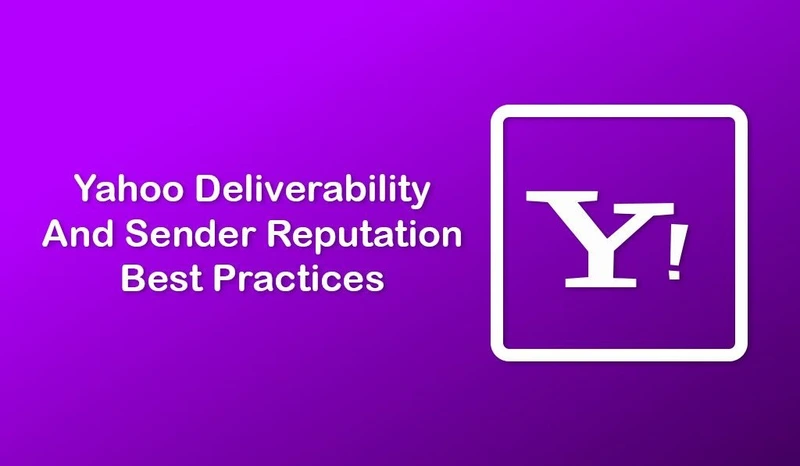- Products
- ProspectSQL/MQL list building with high levels of personalization, real-time data enrichment and prospect search
- Email FinderFind individual or bulk emails by entering the person & company name or domain
- Email VerifierVerify emails addresses individually, in bulk or through API, with 99% accuracy
- Clearout For SheetsVerify email addresses directly on Google Sheets with Clearout for sheets add-on
- ClearoutPhoneValidate phone numbers across 240+ countries in bulk, quick or real time validation Free Tools
- Disposable Email Checker
- Reverse LinkedIn Profile Lookup Tool
- Reverse Email Lookup Tool
- Email List Cleaner
- Resource
- Pricing
- Integrations
- Enterprise
- Login
Best Practices to Improve Yahoo Deliverability and Sender Reputation

Each ISP (Internet Service Protocol) and Mailbox Provider has its own sender guidelines and anti-spam policies. Such policies can be classified for determining the effectiveness of the email marketing campaigns.
• Content- Effective and relevant message with catchy content
• Technical- Including the matters that influence email deliverability
• Technical- Including the matters that influence email deliverability
Only a balance of both these factors can help achieve maximum results from the email marketing campaigns.
One such popular and free email service provider which has a complex anti-spam filtering framework is Yahoo. Knowing how Yahoo mail handles incoming email can help improve the Yahoo deliverability results. This article contains a brief of such policies which you must go through before initiating campaigns with a large volume of emails.
One such popular and free email service provider which has a complex anti-spam filtering framework is Yahoo. Knowing how Yahoo mail handles incoming email can help improve the Yahoo deliverability results. This article contains a brief of such policies which you must go through before initiating campaigns with a large volume of emails.
This article contains
1. How does Yahoo Mail determine a mailer's overall reputation?
2.Factors That Influence Sender Reputation And How to Deal With Them?
3.Important Actions To Be Taken to Improve Yahoo Deliverability
4.Other Successful Yahoo Deliverability Tips Not To Be Missed
5.How Yahoo Mail Validation With Clearout Can Help You Maintain Excellent Inboxing Rates
1. How does Yahoo Mail determine a mailer's overall reputation?
2.Factors That Influence Sender Reputation And How to Deal With Them?
3.Important Actions To Be Taken to Improve Yahoo Deliverability
4.Other Successful Yahoo Deliverability Tips Not To Be Missed
5.How Yahoo Mail Validation With Clearout Can Help You Maintain Excellent Inboxing Rates
How Does Yahoo Mail Determine a Sender's Overall Reputation?
A sender has the risk of getting marked as spam from two sides, either by the recipient or by the spam filtering system which includes evaluation by the mailbox in use. Yahoo takes the following factors into consideration for determining the overall reputation of a user, negative sender reputation being one of them.
• IP address reputation - The Internet Service Provider’s (ISP) constantly evaluates your IP address on the basis of several factors and then uses their own algorithms to assign a rank to you. A good IP reputation establishes your image as trustworthy which ensures your emails get delivered to the assigned addresses.
• URL reputation - It checks if a URL is hosting any malicious content like malware, fraud, phishing, and spam etc. The URL Reputation feature blocks access to the web addresses that are identified as known sources of malicious content.
• Domain reputation - Just like IP reputation, ESP’s use domain reputation to determine how trustworthy your emails are. A poor domain reputation causes your emails to land up in the spam folder. Heavy damage to the domain reputation leads to the transactional emails — order confirmation emails, shipping notifications, and the like— end up in the spam folder
• Sender reputation - A crucial part of email deliverability, sender reputation is a score allotted by internet service protocols (ISP) to an organisation/company that sends emails. If the score falls under a given threshold, the ISP may direct the messages to the spam folder or reject them outright. Several factors go into determining the score and sending emails to invalid email addresses tops the list. It can be easily avoided by using an accurate email verifier to clean your email list regularly and remove the risky email addresses.
• Autonomous System Number (ASN) reputation - Not many users are aware of ASN which is a group of one or more IP prefixes (lists of IP addresses accessible on a network) used by network operators to control routing within their networks and to exchange routing information with other Internet Service Providers (ISPs). Poor ASN management has a direct link to – wrongly acquired – bad IP reputations. Poor IP address inventory management acts as a threat in mailing security hence considered an important factor in determining overall reputation.
• Domain Keys Identified Mail (DKIM) signatures - A DKIM is a working way to prevent email deliverability issues and increase your sender reputation with email services. With this the receiving email server identifies the origin of the email marketing campaign. Most email clients will look forward to a valid DKIM signature on incoming emails to identify who has sent it.
• Domain-based Message Authentication Reporting and Conformance (DMARC) authentication - DMARC is to allow you, the domain owner, to protect your email reputation by: Announcing email authentication practices, Requesting treatment for mail that fails authentication checks, and then soliciting reports about email claiming to be from its domain.

Factors That Influence Sender Reputation And How to Deal With Them?
• Bounce rates - Bounce is of two types - hard bounce & soft bounce. Soft bounce is not a damage to the sender reputation as it indicates non-delivery due to temporary issues that can be fixed. But hand hard bounce is a cause of concern as it indicates reaching out to users via accounts that do not exist. This shows poor management of email lists. Most ESPs penalise your sender reputation if the bounce rate exceeds 5% due to which your emails will land in the spam folder or will be rejected outrightly.
• Complaint rates - Here complaint refers to the recipient marking your emails as spam. Each complaint is like sending a message directly to the ISP that their users do not trust your company. The more the number of complaints, the lesser your sender score will get and with time all your emails will get redirected to the spam folder.
• Spam trap hits - Spam traps look like real email addresses but are used by IPSs to locate spammers. Having spam traps in your email list provides a signal to ESPs that you are not using the double opt-in strategy for registering users. Companies who do not use double-opt in strategies are considered law violators and are restrained from mailing activities, lowering the email activities and sender reputation.
• Changes in emailing frequency and volume - ISPs monitor the consistency of your email campaigns i.e the number of emails in each campaign and how often the campaigns are sent out. For example - IPSs monitor the number of emails sent out from a new IP address. In case a large volume is sent out from a relatively new IP address, it is undertaken as a suspicious activity which may lead to blacklisting of the IP address . In such cases the IP address should be warmed up first.
• User engagement - The way a user interacts with your emails says the lot about the quality of your emails and how trustworthy your brand seems to the people. Good open rates, forwards and shares indicate the value of your content whereas low open rates, delete with acknowledgement shows low interest of subscribers due to which the sender score may reduce substantially.
Follow these steps regularly to clear the Yahoo reputation check
• Regular verification of your yahoo email list : Regular yahoo mail validation will remove invalid, outdated emails, addresses with typos and spam traps too.

• Use double opt-in: Use of double opt-in will ensure all users subscribing are genuine and are willing to receive messages from you.
• Regular filtering of inactive subscribers: Clean yahoo email list regularly to remove users who have not been engaging to your emails. If there are recipients who haven’t opened or reacted to your emails for an extended period of time there is a possibility that the email address is no longer in use.
• Warm up the IP address: This applies to a new IP address in use to avoid any suspicion from ISPs
• Publish reverse DNS (PTR) records for the sending IPs in use: It is an anti-spam measure. Reverse DNS is the opposite of standard (forward) DNS the absence of which affects the sender reputation with Yahoo. Standard DNS resolves a domain name into an associated IP address. In contrast, reverse DNS resolves an IP address into a domain name.
• Warm up the IP address: This applies to a new IP address in use to avoid any suspicion from ISPs
• Publish reverse DNS (PTR) records for the sending IPs in use: It is an anti-spam measure. Reverse DNS is the opposite of standard (forward) DNS the absence of which affects the sender reputation with Yahoo. Standard DNS resolves a domain name into an associated IP address. In contrast, reverse DNS resolves an IP address into a domain name.
Important Actions To Be Taken to Improve Yahoo Deliverability
• Whitelisting with Yahoo - Yahoo Mail does not have a whitelist program like other leading service providers but they have a program where email marketers can submit their IPs for review. Just fill out and submit the application for new IPs. On completion of review the Yahoo mail team will decide on how to modify your reputation in the system.
• Join the Yahoo Feedback Loop Program (FBL) - Yahoo Feedback Loop can be termed as Yahoo reputation check program wherein the email marketers can check and identify the campaigns that are receiving high number of complaints from the Yahoo mail users. To avail this service the user needs to sign their outbound emails with DKIM ( Domain keys Identified Mail)
• Join the Yahoo Feedback Loop Program (FBL) - Yahoo Feedback Loop can be termed as Yahoo reputation check program wherein the email marketers can check and identify the campaigns that are receiving high number of complaints from the Yahoo mail users. To avail this service the user needs to sign their outbound emails with DKIM ( Domain keys Identified Mail)
• Use of Yahoo Postmaster Tool - Use of various Yahoo Postmaster tools you may monitor and analyse the email health and locate the right routes for the email messages to reach the correct place.
• Make sure the emails are DKIM signed - Yahoo DKIM check is important as DKIM signature verifies if you are who you are claiming to be. DKIM assures the ISPs that your messages can be processed safely as the behaviour does not resemble that of spammers. Yahoo DKIM check lets it attach a new domain name identifier to your message.
• SPF (Sender policy framework) validation - Implement a Sender Policy Framework to validate email envelopes. This verifies the sending mail server and the sending email address too. Using the SPF protocol, the domain owners can publish a list of IPs authorised to send emails on their behalf.
• SPF (Sender policy framework) validation - Implement a Sender Policy Framework to validate email envelopes. This verifies the sending mail server and the sending email address too. Using the SPF protocol, the domain owners can publish a list of IPs authorised to send emails on their behalf.
Other Successful Yahoo Deliverability Tips Not To Be Missed
• Do not overlook the subject line. Email subject line is vital because users will make a choice dependent on them and if messages are being deleted
without being read, that will affect your sending reputation.
• Opt out users that have marked your email as spam previously.
• Use separate IPs relying upon the email's content.
• Don't include: HTML forms, JavaScript, or embedded objects (like flash or ActiveX.)
• Send an email just to the individuals who need it.
• Ensure that the subscribers have actively verified their intent to receive your mailings.
• Honor the frequency of the list's intent. For example - do not start sending daily emails to subscribers of your monthly mailing.
• Review SMTP reply codes frequently.
• Consider regularly using a mailing list validation service to clear potentially harmful emails, leaving you with a verified email list.
• Your SMTP servers ought to recognize the IP address of the email and indicate this in the email headers to help you diagnose spam problems.
without being read, that will affect your sending reputation.
• Opt out users that have marked your email as spam previously.
• Use separate IPs relying upon the email's content.
• Don't include: HTML forms, JavaScript, or embedded objects (like flash or ActiveX.)
• Send an email just to the individuals who need it.
• Ensure that the subscribers have actively verified their intent to receive your mailings.
• Honor the frequency of the list's intent. For example - do not start sending daily emails to subscribers of your monthly mailing.
• Review SMTP reply codes frequently.
• Consider regularly using a mailing list validation service to clear potentially harmful emails, leaving you with a verified email list.
• Your SMTP servers ought to recognize the IP address of the email and indicate this in the email headers to help you diagnose spam problems.
How Yahoo Mail Validation With Clearout Can Help You Maintain Excellent Inboxing Rates
A healthy email list lets you avoid most of the problems as it builds up a strong sender reputation. A good sender reputation equals a better inboxing rate. So all you need is an email verification tool with the most reliable accuracy in the industry specially in yahoo deliverability.
Clearout email verification and validation provides highest industry mail performance ratios for Yahoo and AOL with 96%+ accuracy by carrying out more than 20+ refined validation checks to conclude the status of every email address in your data.
Clearout algorithms are uniquely designed to identify the invalid, disposable, catch-all and other risky email addresses in your email lists. With Clearout API integration you may avoid any wrong email address sign up/register and be a part of your email lists. This builds up a strong sender reputation and better inboxing rates.
Validate Your Yahoo Email List With Clearout.io
Have a query? Reach out to us...
Recent Posts
01 Jul 2025
Best Zoho CRM Integrations for Sales & Marketing in 2025
Discover the top Zoho CRM integrations in 2025 categorized by use case. Explore how each tool's key ...
01 Jul 2025
Sales Automation in 2025: The Guide to Close More Deals Faster
Struggling with manual sales workflows? Follow this guide to explore the sales automation use cases, ...
25 Jun 2025
Top 6 Email Finder APIs in 2025 for All Use Cases
Looking for a reliable Email Finder API? Explore the top 6 email finder APIs of 2025—compare key fea ...
17 Jun 2025
Top 10 Email Spam Checker Tools Tested & Reviewed (2025)
Check out the top 10 email spam checker tools to avoid junk folders. Compare features, ratings & use ...
06 Jun 2025
How To Create a Lead Magnet That Converts in 2025
Looking for more leads? Read how to create a high-converting lead magnet in 2025 with step-by-step g ...
Prospecting ,Email Finder & Email Verification Service
Prospecting ,Email Finder & Email Verification Service
Expand your reach by discovering and verifying the ideal prospects.
Sign up & get 100 free credits | No Credit Card required




